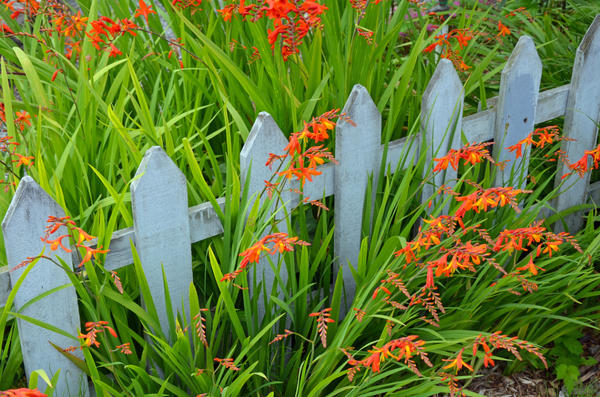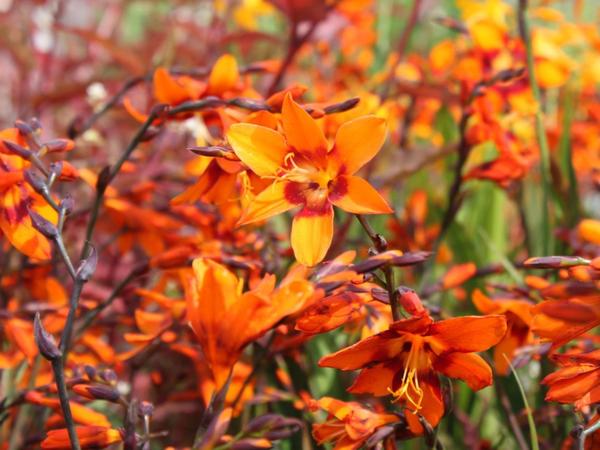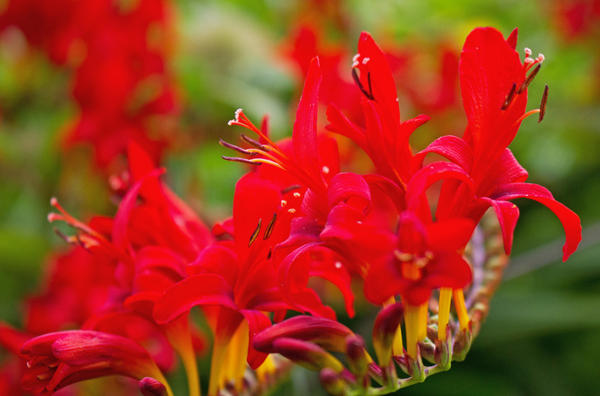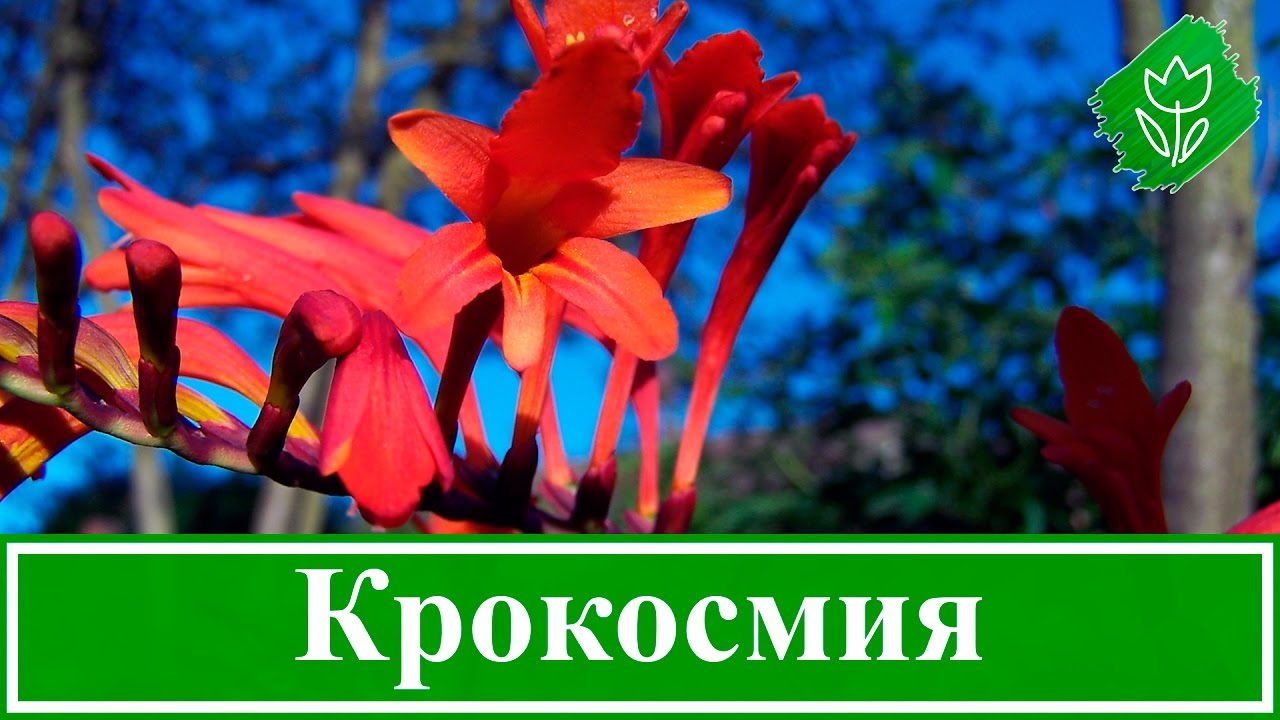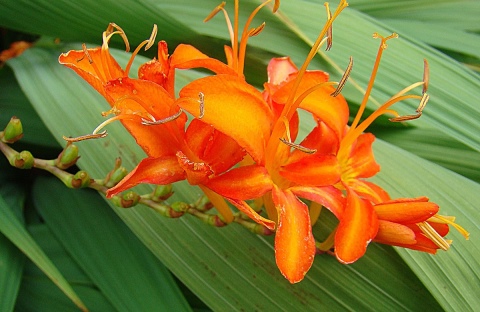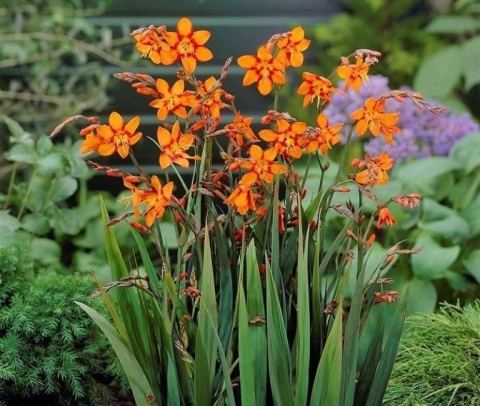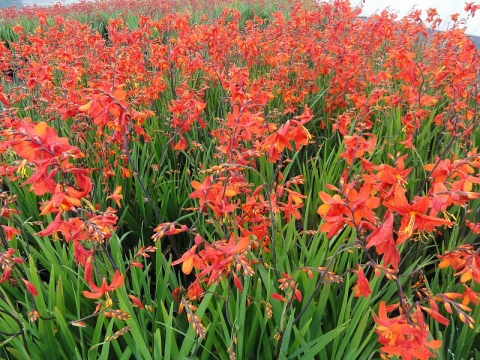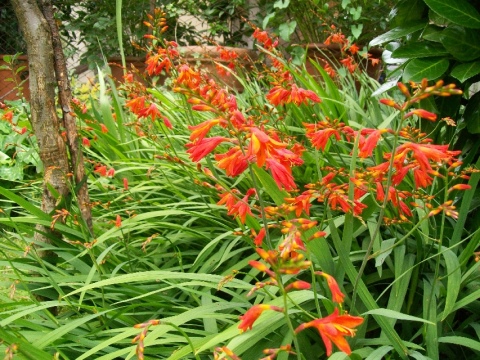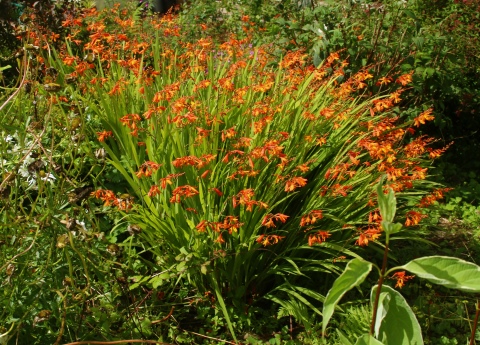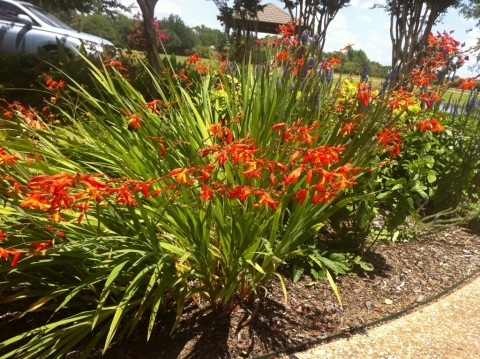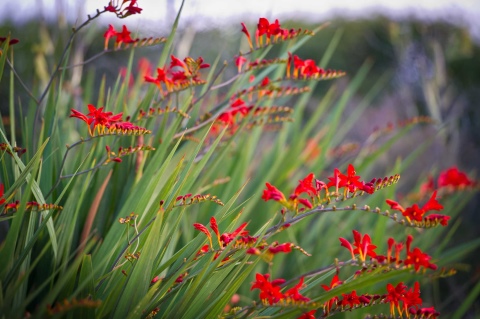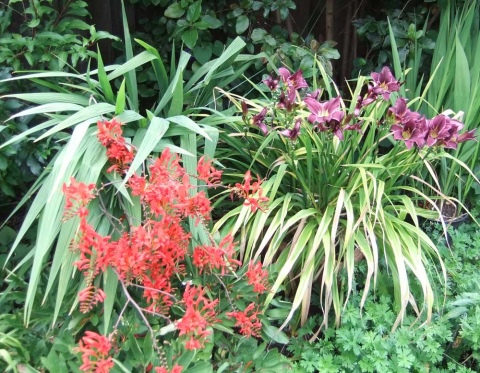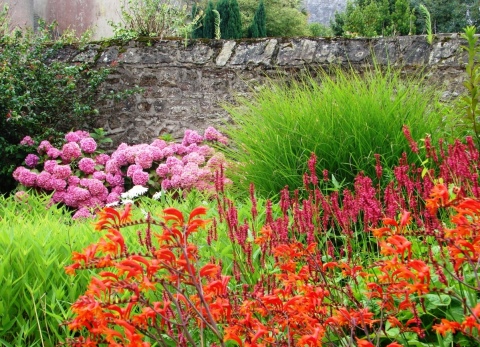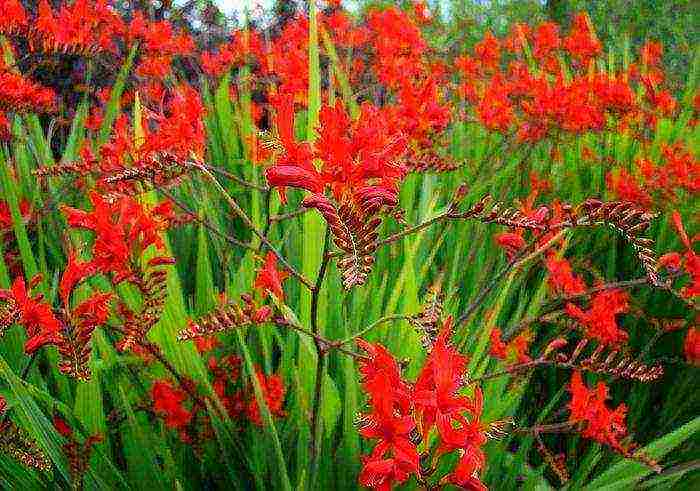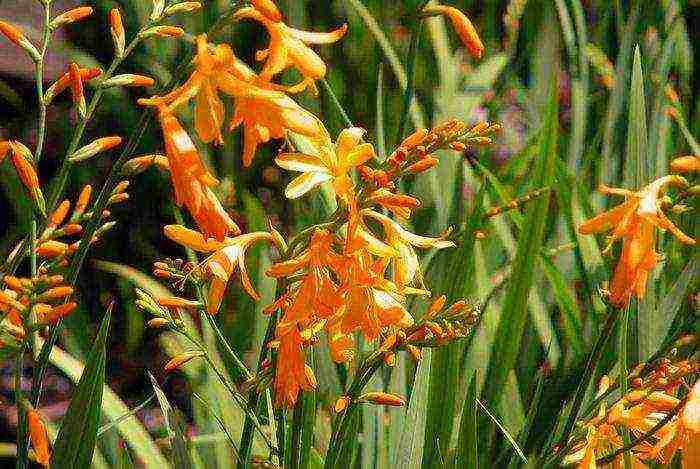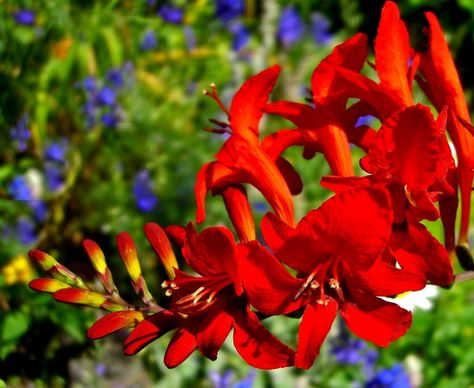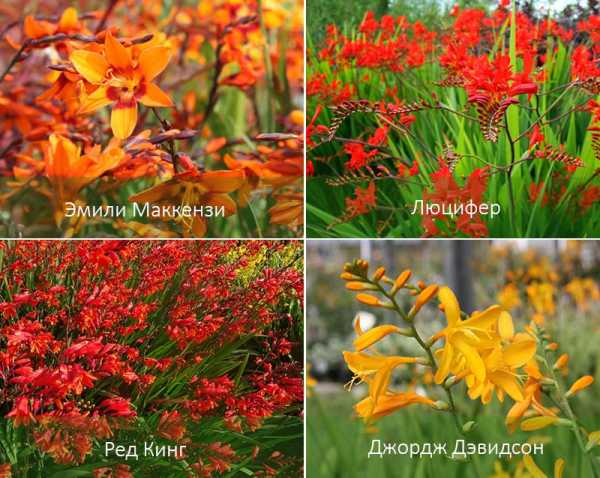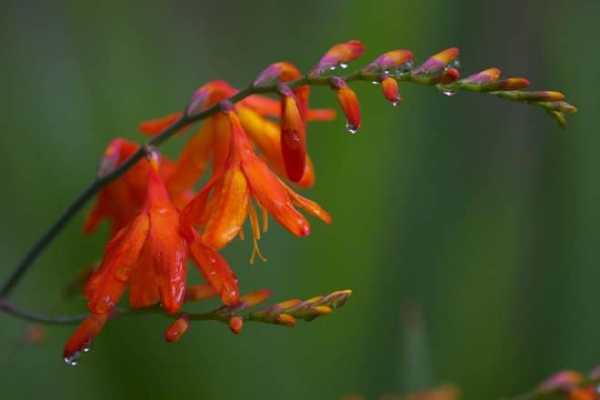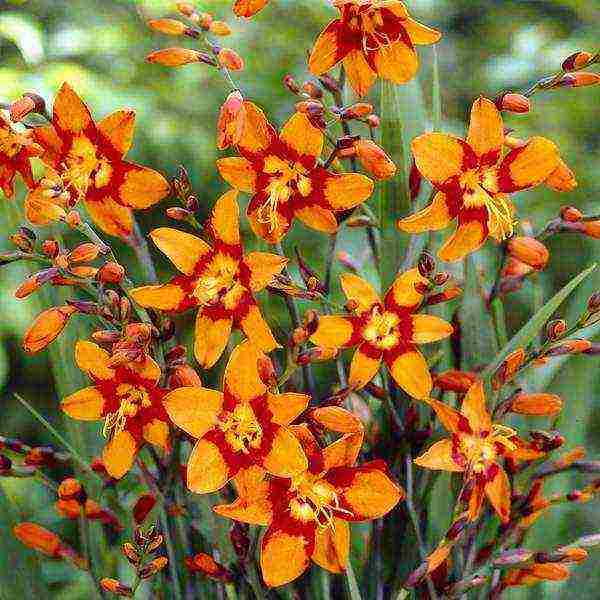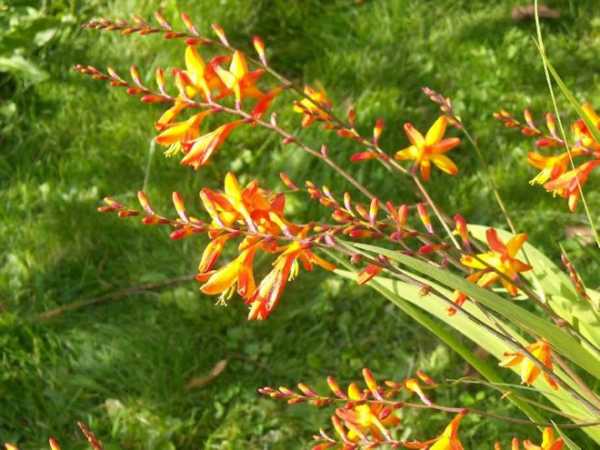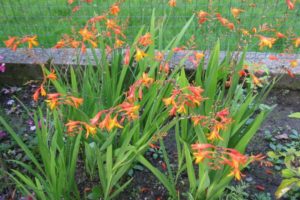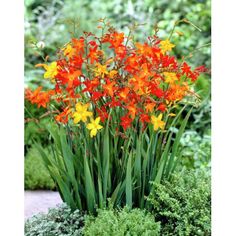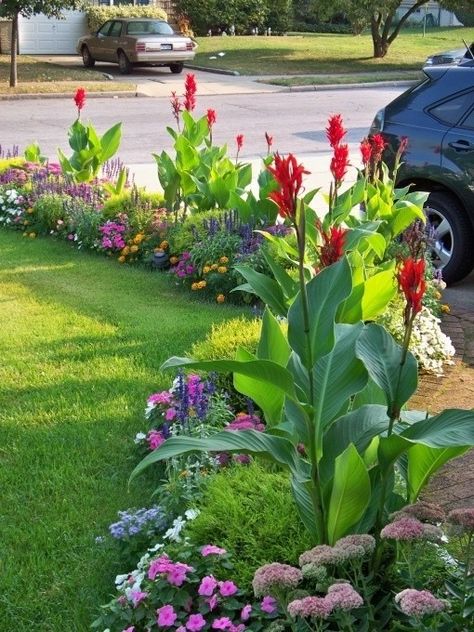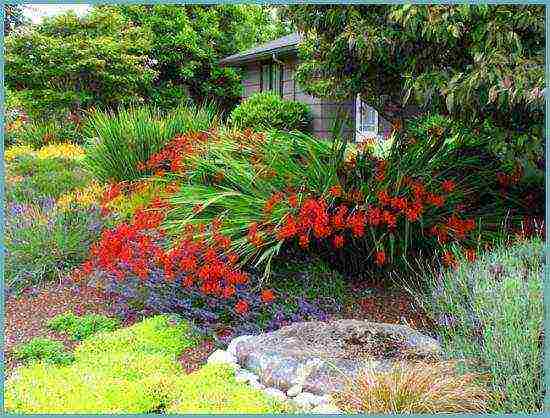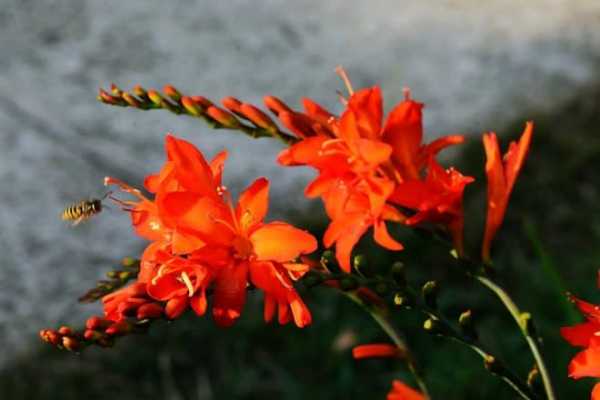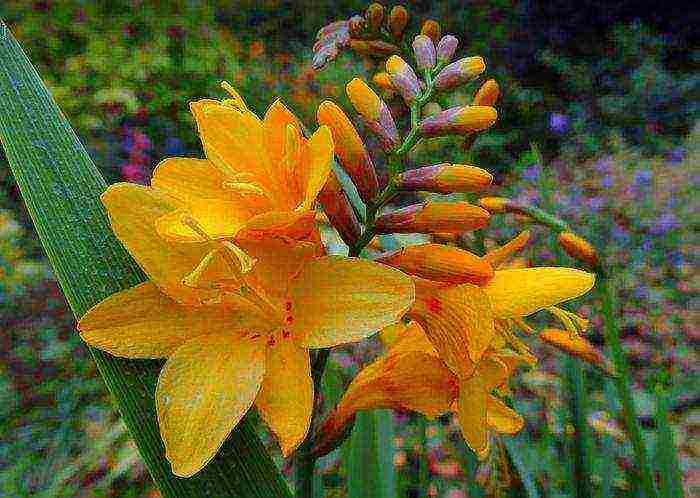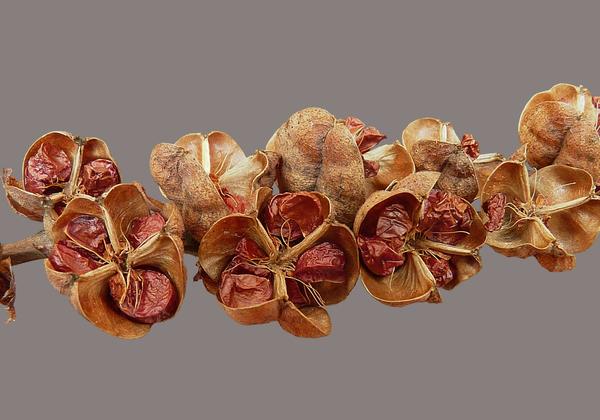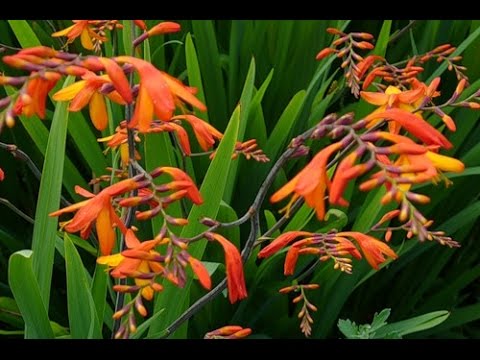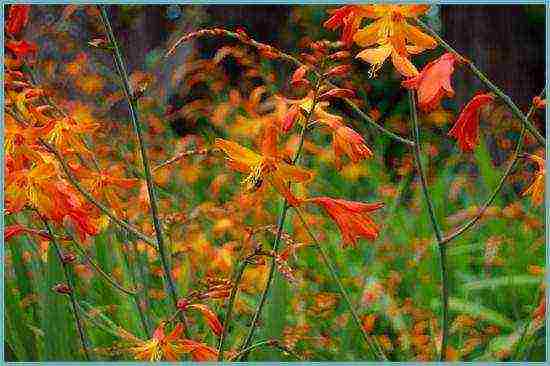Bulbous hyacinths
Nature has endowed some species with unusual sophisticated beauty, while others it has given a wonderful aroma.
Belvalia
2 spring flowering species are interesting:
- with dark colored flowers (similar to muscari);
- with blue flowers (reminiscent of pushkinia).
Belvalia is dark purple. Belvalia hyacinth. B. dark purple (Bellevalia atroviolacea) originally from Afghanistan. Its parameters: height - 15-20 cm, width - 5 cm. Winter hardiness -15 ° С.
B. hyacinth (B. hyacinthoides) originally from Greece; about 5-15 cm high, 5 cm wide. Winter hardiness -5 ° C, so it is better to grow it with a shelter, without it - on the South Coast and the Black Sea coast of Krasnodar Territory.
Brimer amethyst
An interesting representative of the bulbous, resembling a hyacinth.
Brimer is amethyst. Photo from uniprot.org Her white-flowered form.
Brimera amethyst, or Spanish hyacinth (Brimeura amethystina, syn. Hyacinthus amethystinus) - winter-hardy bulbous from the Pyrenees (the British give it a winter minimum within -15 ° C); up to 10-20 cm high, 5 cm wide. Decorative form: var. alba (white flowers). Grown as hyacinth.
Galtonia white
Unusually beautiful bulbous plant with drooping flowers; abundant bloom is luxurious!
Galtonia is white.
Galtonia white (Galtonia candicans) is native to South Africa, despite this, it tolerates -15 ° C; up to 1-1.2 m high and up to 10 cm wide. Flowers are white, bell-shaped, drooping, fragrant, collected in a brush; bloom at the end of summer.
It is undemanding to light and soil. Propagated by seeds and daughter bulbs; not damaged by naked slugs.
Hyacintella blanching
From a distance, it looks like hyacinth, woodland and muscari at the same time: only upon closer examination you realize that this is neither one, nor the other, nor the third.
Hyacintella turns pale.
Hyacintella (Hyacinthella) originally from Croatia; height - 10 cm, width - 5 cm. Flowers are bright blue, collected in dense brushes; bloom in the spring.
Winter temperature minimum -15 ° С. Planting and caring like hyacinths.
Camassia Kuzika
She is charming, her discreet beauty looks exquisite.
Camassia Kuzika, photo by the author
Camassia cusickii is a native of the United States. Its parameters: height - 60-80 cm, width - 10 cm.
Camassia Kuzika in the May rockery, photo by the author
How to grow it is described in detail in the article Camassia, a rare guest of flower beds.
Eucomis pale-flowered
An exotic member of the family that brings southern charm to flower gardens.
Eukomis pale-flowered enchants on the South Coast from August to October, photo by the author
Eukomis pale-flowered (Eucomis pallidiflora) is a very beautiful summer-flowering bulbous plant, which retains its decorative effect in the south until mid-autumn. For him, -5 ° C is critical, therefore, cultivation can be recommended for the southern regions with shelter, in warm places - without it. In addition, its bulbs can be planted in containers, dropped into open ground in the spring, and brought into the basement for the winter. Propagated by daughter bulbs.
What else to look at on the eukomis website:
The exotic beauty of eukomis
And what iris and hyacinth curiosities grow in your country house?
Description
Crocosmia is a perennial plant with a thin erect stem, reaching a meter in height, with narrowly obvious or linear light green half-meter leaves of a corrugated structure, 0.5 to 3 cm wide. A deep groove runs along the leaf. Montbrecia can grow up to 150 cm high. The stem has powerful peduncles with dense spike-shaped or paniculate inflorescences. Peduncles with numerous buds grow in the middle of summer. The buds bloom in turn, releasing a dozen bright flowers.
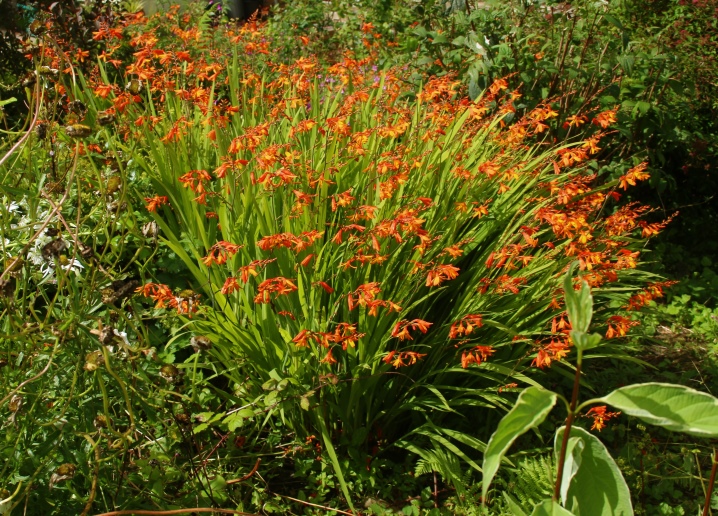
On one stem of a cultivated variety of Japanese gladioli, there can be up to 10 of them, in contrast to wild ones, which produce only 5 flowers each. Small flowers (4 cm) with petals ranging from yellow, orange, red and brown, tubular or star-shaped, resemble a funnel.These bright petals of inflorescences can be compared with fiery tongues, or even with red-winged moths. Montbrecia blooms in early summer and blooms until frost. Faded flowers simply fly off the arrow, the rest continue to bloom, so the perennial always has a decorative look.
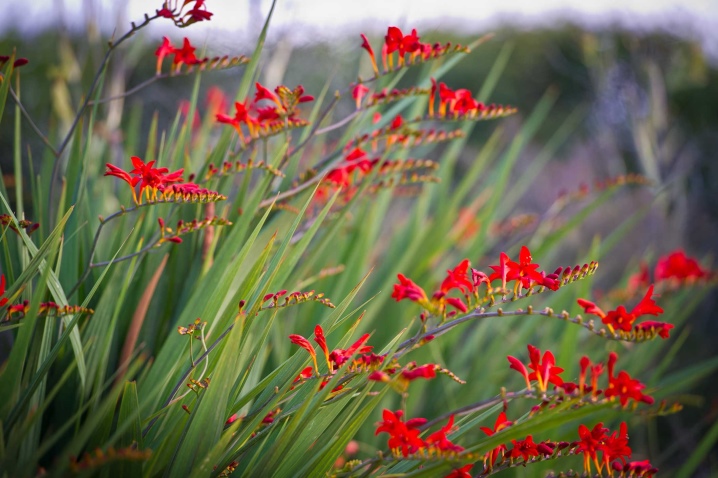
After the end of the flowering season, the fruit ripens in the form of a polyspermous rounded box with large brown seeds. The root system is a few overgrown corms with brown shells. The multi-layered 3 cm bulb is slightly flattened. During its growth, the mother bulb grows overgrown with tubers. In the spring, the bulbs sprout, and then a stem that is one and a half meters long extends from it.
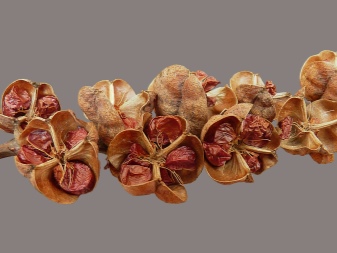
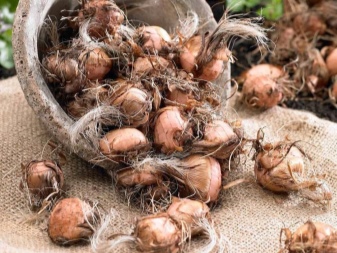
European gardening culture has been familiar with crocosmia since the 19th century, and its hybrids appear in the 20th century. Having crossed two types of crocosmia: golden and Potts, the French breeder of ornamental plants Victor Lemoine in the 19th century grew a hybrid culture, which is now called common crocosmia.
Planting gladioli
Gladioli like soil that is well loosened and easily saturated with moisture.
It is important that the turf in the country is rich in humus and fertile. The optimal acidity index is close to neutral
In addition, the following guidelines should be considered.
- In the spring, before introducing the bulbs into the soil, the area allotted for planting is carefully dug up, adding fertilizers to it. Compost or humus in a volume of 12 kg per square meter is suitable. It will also be useful to add mineral flower complexes in the amount recommended by the manufacturer.
- If there is a large volume of clay in the composition of the soil in the area, its additional cultivation is necessary. To make the soil more fertile, it is recommended to apply a mixture of coarse sand, gravel and wood ash (from 500 g per m²).
- When planting cultivated varietal gladioli in areas with lowlands or high soil moisture, care should be taken to form embankments with good drainage. It is in them that the flowers will be planted. The height of such ridges should be at least 30 cm.
The planting process is not difficult for an experienced summer resident. In the spring, the corms are taken out of their storage area, subjected to a thorough examination. For planting, only those that have retained a dense structure are suitable, do not have spots, ulcers, and wet areas on the surface. They are taken out 7 days before being placed in the ground and left in a lighted place for sprouts to appear. This approach will help to reject non-viable planting material.
On the eve of planting, it is important to soak the corms in a solution of manganese or special antifungal drugs. After such treatment, they will not be afraid of the development of diseases.
The best time for planting a skewer in open ground is in the 2nd or 3rd decade of May, when the soil acquires a stable temperature of 10 degrees and above.
Seedlings will appear after 1-2 weeks. If there were already sprouts on the corms, the process will go faster. If the soil is warm enough, short-term frosts will not harm the plant.
It is important to remember that gladioli cannot be planted in one place for more than 2 years. In addition, children and adult corms are not placed nearby.
Preparing the soil for gladioli will require some effort. Gladioli grow well on any cultivated soil, but best of all - on light sandy loam, with a lot of humus. Be sure to add sand to clay soil.
In spring, gladiolus beds must be dug up, leveled and fertilized with ammonium nitrate (15–20 g per sq. M), double superphosphate (10–15 g per sq. M) and potassium sulfate (25–30 g per sq. M). When planting, you can additionally add wood ash - 40-60 g per running meter.
In no case do not plant gladioli in one place for two seasons in a row - they will hurt.In addition, avoid areas where phlox, asters and other flowers that are susceptible to fungal diseases similar to gladioli used to grow. Suitable precursors are cucumbers, onions, garlic and strawberries.
Do not plant gladioli in one place for two seasons in a row - they will hurt
Landing
In order for gladioli to please with generous flowering, it is necessary to choose a suitable place and plant the corms correctly. It is known that gladiolus is light and sun-loving. Therefore, when choosing a place for it, you need to make sure that the garden bed is clearly oriented from east to west.
In central Russia, gladioli are planted in the first half of May, if the soil has already warmed up to 10 degrees Celsius. With sufficient humidity and a relatively low temperature, the roots develop intensively and a powerful root system is formed, which further provides the plant with normal nutrition.
Before planting gladiolus corms in the ground, they are cleaned of dry scales; in those partially affected by the disease, unhealthy areas are cut out, and the cuts are sprinkled with crushed charcoal. True, all this can be avoided if, when buying, you carefully examine the tubers - they should not have rot and mold.
Pay attention to the bottom: if it is small, then the bulb is still young.
The planting depth is influenced by both the size and age of the corms and the quality of the soil. On light soils, they are placed at a depth of 10–12 cm, on loamy soils - 2–3 cm higher. Small gladiolus tubers are located 5-8 cm from the surface, children are not lower than 3-5 cm, and they are planted a week earlier than adult bulbs. After planting, the bed is sprinkled with peat or humus by 2-3 cm.
And if you put it deeper? First, gladioli will bloom later. Secondly, a larger corm will form, but there will be fewer children. And the most unpleasant thing is that in a cool summer, bulbs can infect fungal and bacterial diseases.
Crocosmia: varieties and varieties
A delightful plant with flowers of various shades, crowning a long peduncle, grows naturally in the central regions of Africa. At the end of the 19th century, Lemoine, a breeder from France, managed to breed hybrid varieties of tritonia with magnificent flowers. Since then, the flower has been widely grown in gardens and parks, and is now used for landscape compositions as a perennial plant. Another name for crocosmia is montbrecia.
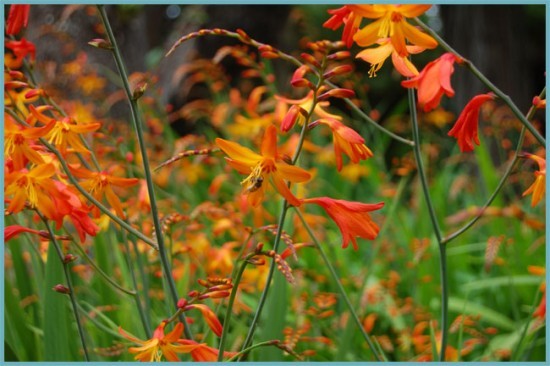 Crocosmia is an unusual plant that is increasingly used in landscape design.
Crocosmia is an unusual plant that is increasingly used in landscape design.
In total, about 50 species of montbrecia are known, of which two are used in landscape design, while perennial hybrids are represented by varieties that are unique in color.
Cultivation of crocosmia in the open field has certain agrotechnical rules, the observance of which guarantees the perfect flowering of plants.
In landscape design, the following varieties of tritonia are used to create flower arrangements in the open field:
-
Emily Mc Kenzie - symmetrical flowers of brown-yellow color in bright tones with late flowering. The height of the bush reaches up to 0.6 m.
Emily mc kenzie
-
Norwich Canary - drooping peduncles of this variety, crowned with a sultan of yellow canary flowers, look like a firebird's feather. The height of the bush is 0.6 m.
Norwich canary
-
Star of the East - the flowering time of this variety lasts until the first frost. The tall peduncle bears apricot-colored bells of a star. The diameter of the flower reaches 10 cm. In winter, perennial rhizomes are easily damaged by frost, so the variety requires a reliable shelter.
Star of the east
-
Lucifer grows up to 1.5 m. A rich palette of colors ranging from pastels to bright fiery thick tones allows this variety to be used to create any compositions in landscape design.
Lucifer
- Early flowering varieties of montbrecia include Crocosmia paniculata. Tall plants bloom in June with modest orange flowers.
Crocosmia paniculata
Landing features
For planting and growing montbrecia, the brightly lit area of the dacha is most suitable, since in partial shade the decorativeness of the plant goes out, the period and quality of flowering decreases. The best soil for montbrecia is a soil rich in organic matter.
Sowing montbrecia
Montbrecia is propagated in various ways - by children, corms and seeds. When choosing a seed planting option, it is worthwhile to understand that it is better in this case to use the seedling method, since in the open field the germination of seeds is significantly reduced.
Before planting seeds, you need to prepare them. To do this, the seeds are soaked for 24 hours in ordinary water, trying to replace it every 6-8 hours. Then the seed is sown into a substrate, which should consist of sand, peat, earth and humus. Seed containers are placed on a light windowsill and covered with foil. This completes the landing of the montbrecia.
Seedling care
Further care of the crops is reduced to the usual activities for the care of seedlings:
- When the first shoots appear, the cover (film) is removed.
- Watering is carried out as needed.
- The soil around the seedlings is gently loosened.
The soil around the montbrecia is regularly watered and loosened.
Important. The seedling substrate should always be slightly damp, but not damp.
Otherwise, the death of sprouts from drought or from waterlogging and fungal diseases may occur.
Montbrecia's pick
When the sprouts have 2-3 leaves, it is time to dive the seedlings into separate containers. The containers should be large enough as the plants will survive until they are planted outdoors.
A couple of weeks before the planned planting, the seedlings need to be hardened. To do this, young shoots are taken out into the street, starting with a few minutes of the plants being in the fresh air, daily increasing the hardening duration.
Montbrecia and group planting care
Montbrecia is practically no different from other bulbous plants in terms of caring for group plantings. But, it must be constant and designed to control the soil moisture level. Waterlogging leads to the fact that the root tubers begin to rot and die. An infectious bulb quickly transfers the fungus to another planting material, as a result, group plantings lose their decorative effect and rot completely.
Montbrecia is very fond of nutrients. She quickly consumes them from the soil, so in the summer season you need to periodically feed the plantings with mineral fertilizers. Also, you can alternate the formulations with watering the plant with a solution of bird droppings or sour mullein. In warm regions, where it is not necessary to prepare the montbrecia for wintering in separate containers indoors, you need to water the plants with potassium solutions.
Despite the fact that crocosia is often planted in ventilated heights without protection, it is recommended to tie the peduncles to vertical perches. To ensure that there are enough nutrients in the soil for plantings, cut off the inflorescences at the beginning of flowering and after the buds begin to fade.
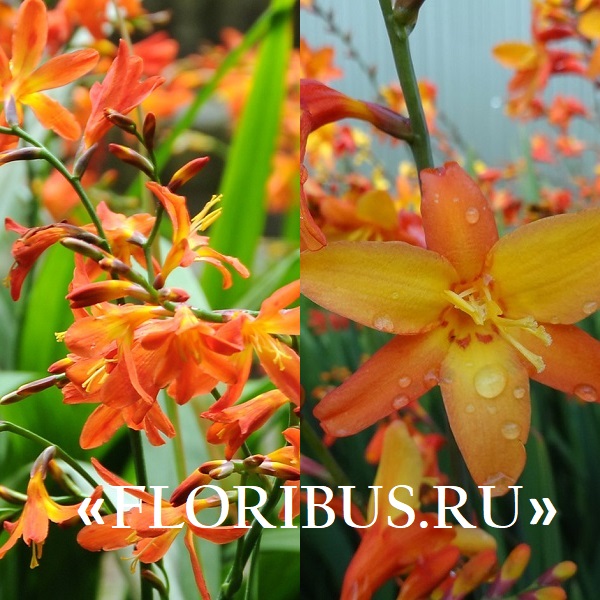
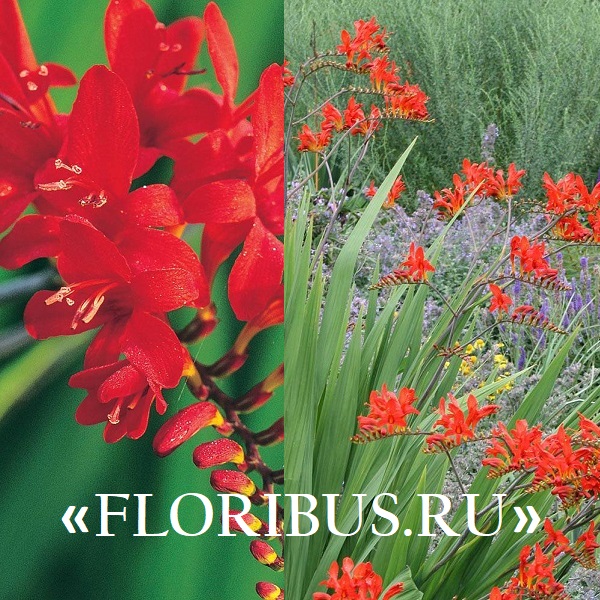
Types and varieties of crocosmia with photos
There are approximately 55 natural species of crocosmia. Below will be a description of the most common species cultivated by gardeners.
Crocosmia golden (Crocosmia aurea)
This species is native to the Republic of South Africa. The leaf plates have a xiphoid or linear shape, and the flowers have a rich orange-yellow color. Flowering in this species is observed at the beginning of the autumn period. It has been cultivated since 1846. There are several forms that have flowers of red, orange and yellow.
Crocosmia masoniorum
A compact bush in height can reach from 0.6 to 0.8 meters. Ribbed leaf plates of a xiphoid shape in width can reach 5 centimeters.The small flowers are rich orange in color, and they are part of the horizontal deviating racemose inflorescence. Flowering occurs in mid-summer. This species is the most frost-resistant in comparison with the rest.
Crocosmia paniculata
The species is tall, so the bush can reach a height of one and a half meters. The sheet plates are corrugated. This species is the earliest flowering, while flowering is observed in the second half of June. Small flowers of rich orange color are collected in panicle inflorescences.
Crocosmia pottsii
Under natural conditions, it can be found in Africa, while this species prefers to grow in swampy areas. In this regard, it is recommended to plant it in a shaded place, in which the soil will not dry out very quickly. The leaves of this species are narrow and smooth, the flowers are small in size.
Crocosmia ordinary (Crocosmia crocosmiiflora), or garden montbrecia
This plant belongs to the first crocosmia garden hybrids. It was created by Lemoine in 1880, while for crossing he used the golden crocosmia and Potts crocosmia. The height of the bush can be up to 100 centimeters. There are thin branched shoots, narrow erect leaf plates of a wide-linear or xiphoid shape and a pale green color. Small red-orange or yellow flowers are funnel-shaped, and they are part of paniculate inflorescences. Flowering is observed in July or August.
Breeding work on crocosmia is ongoing. So, more than 400 cultivars have already been created. The most popular ones are:
- Emily Mackenzie. The height of the compact bush reaches 0.6 meters. The upright arrows have a large number of brownish-orange flowers, which have a speck of bright color in the middle.
- Crocosmia Lucifer. The bush can reach a height of 150 centimeters. On its straight peduncles there are deep red flowers. This variety has a high frost resistance and if the winters are not too frosty in the region where it is grown, then the corms of such a plant can be left in the soil for the winter.
- George Davidson. The bush reaches a height of about 0.7 meters. Its amber yellow flowers look very impressive against the background of dark green leaves. This plant is great for cutting. Bloom is observed in July and August.
- Red King. The middle of deep red flowers is colored orange.
- Spitfire. The height of the bush can reach up to 0.6 m. Flowering is observed from August to the last days of September. The flowers are colored fiery orange.
- Mandarin Queen. The bush can reach a height of 1.2 meters. The color of the flowers is rich orange.
Also excellent for decorating flower beds are such varieties as: Babylon, Golden Fleece, Star of the East, Norwich Canari, Mistral, Vesuvius, Bouquet Parfait, Lady Oxford, Reingold, Heath Magesti, Lady Wilson, Aurora, France Hals, Jace Coy, Lady Hamilton and etc.
Crocosmia is a herbaceous bulbous plant from the Iris family. It forms dense green thickets, over which bright erect or drooping inflorescences bloom. The name means "aroma of saffron", this is how dried flowers smell. The plant is also known by the names "montbrecia", "tritonia" or "Japanese gladiolus". Crocosmia is native to certain regions of South Africa. Its slender thickets will perfectly complement the flower arrangement in the garden, and cut inflorescences will stand in a vase for more than two weeks.

Gladiolus crocosmia - planting and care in the garden
Time to board
The right time for planting seedlings in open ground comes when the minimum daily temperatures are set at least 6o above zero. For the middle lane, this is the end of April - May.The place of permanent residence of the Japanese gladiolus should be a site completely open to sunlight, otherwise the bloom of the montbrecia can not be expected. This plant loves soils in which there will be no stagnation of moisture. Constantly moist soil threatens with rotting and disease. It is better to prepare a bed for planting crocosmia in the fall. The soil is enriched with humus, lime, phosphate fertilizers and potassium chloride. Nitrogen fertilizers are added in the spring.
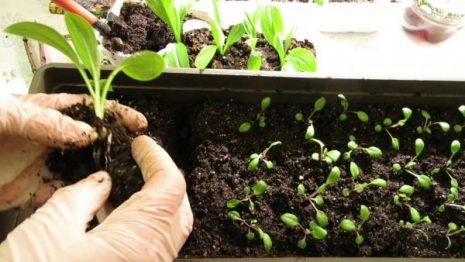
Each seedling is placed in a separate hole and watered well with water. In order for the seedlings to survive the transplant less painfully, for 2-3 days you need to make a canopy over it from the sun's rays.
The optimal distance between holes is 10-12 cm and 25-30 cm between rows.
Planted from seedlings, crocosmia does not flower in the first year. With good care in a suitable place, flowers can bloom in the second year, usually only in the third.
Growing
Planting and caring for montbrecia in the open field is no different from caring for ordinary gladioli and comes down to weekly abundant watering and loosening the soil after watering, and weed cleaning as needed.
If the flower bed takes place on fertile soil, there is no need for additional feeding. Lean, infertile soils require additional application of organic fertilizers in solution every 10 days, and potash - during bud opening.
Reproduction
Every year, many offshoots grow around the mother bulb, which begin to bloom on their own the next year. The old corm does not die off, but continues to grow further. Caring for Japanese gladiolus includes periodic division and transplanting of daughter bulbs. The bushes are dug up in the fall, and a new planting is carried out in the spring, at the same time as the planting of seedlings from seeds. You can plant the bulb first in a pot, germinate a little, and then transfer it to a flower bed, carefully, along with an earthen clod.
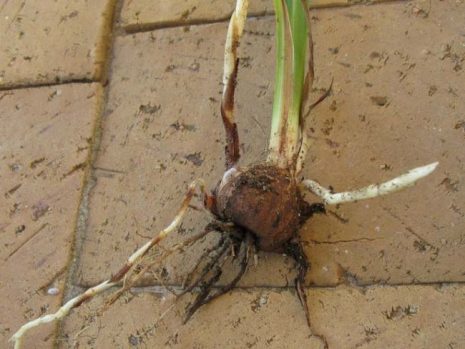
It is advisable to plant different varieties of crocosmia away from each other in order to maintain the purity of the color. Planted together are pollinated and lose brightness.
Possible pests and methods of dealing with them
Perennial Japanese gladiolus is a plant resistant to various types of diseases. However, excessively moist soil, as well as excessive drought and insect infections, can cause some diseases.
- Fusarium. Signs: the leaves dry up, the peduncles dry and curl, the color of the flowers fades. Control: fungicide treatment.
- Gray rot. Signs: gray bloom affects the bulb, the plant dies. The reason is waterlogging.
- Jaundice. Signs: the tips of the leaves turn yellow, then the whole plant turns into straw and dies. The reason is a viral infection. Struggle: the affected plants do not resume, healthy ones must be transplanted to another place, the bulbs and seeds must be treated with potassium permanganate before sowing.
- The main pests of montbrecia are spider mites, bears and thrips. Fighting: spraying with chemicals, using folk methods of fighting, traps for bears.
Basic rules for growing
Before you start growing gladiolus in your garden, you need to familiarize yourself with the 11 most important rules that will help you grow healthy plants with beautiful flowers:
It is impossible to grow such flowers in the same place for more than 2 years. In the third year, a different place is chosen for their planting.
During the transplant of gladioli, you need to try to choose a site whose soil composition will differ from the previous one. For example, if flowers were grown in light black soil, then they can be planted in sandy loam soil.
Purchase the planting material that has been adapted to the climatic conditions of your region.This is due to the fact that these flowers react extremely negatively if they get from a warm climate into a damp and cool one. When purchasing planting material from Holland, remember that such gladioli will bloom magnificently and very effectively, but only once.
Large bulbs should not be planted near children, as they will oppress them. It is recommended to plant in order: from small bulbs to large
Experienced gardeners recommend choosing the largest corms and planting them separately.
It is very important to plant the corms at the correct depth. In heavy soils, the bulb is planted to a depth equal to 3 of its diameters, and in light soils - four
If the bulb is buried very deeply in the soil, then this can cause the lack of flowering. And if it is not deepened to a deep enough depth, then an arrow garter may be needed.
When 3-5 days remain before the daughter bulbs are planted in open soil, dense scales will have to be removed from them, otherwise the sprouts may not appear. When they are planted, they are watered once every 2 days.
This is a light-loving plant. If the late variety is grown in a shaded place, then its flowering can not wait at all. However, early varieties, if desired, can be grown in a shady or semi-shaded place, but in this case the bushes will bloom much later.
The area where flowers grow must be ventilated, otherwise the bushes can infect fungal diseases.
If the flowers are grown in sandy loam, then they must be regularly fed on foliage.
In the summer, the bushes should be watered about once every 7 days, but at the same time abundantly enough
During a long dry period, they are watered daily in the evening, after which the surface of the soil is loosened, bushes are huddled and weeds are pulled out.
Dig up the corms and store them correctly, and you should pay special attention to this.
A noble handsome man in your flower bed. Gladioli: basic rules for growing
Reproduction methods
Reproduction of crocosmia is carried out by seed and vegetative methods. Seeds are pre-sown for seedlings in order to get a more mature plant by spring. In February, a mixture of peat, turf, sand and leaf humus is placed in flat boxes. Seeds should be soaked in warm water for a day, which should be changed 4 times. They are sown to a depth of 3-5 mm. The container is covered with glass and placed in a warm, bright room. After 1-2 weeks, the first shoots appear. Young plants continue to grow at home until early May. Fortified seedlings are transplanted into open ground when the risk of spring frosts disappears.
A more convenient way of reproduction is to divide the corms. Each year, up to six children are formed on the rhizome. Moreover, the mother bulb remains viable. In the fall, when the foliage is completely dry, the tubers are dug up. In central Russia, they are stored until spring in a warm place where frosts do not penetrate. When transplanting, you can divide a large curtain into several parts, but you should not plant the corms one by one.

Description of the plant
Crocosmia is a herbaceous perennial. The length of the plant can range from 40 cm to 1 m. Its root system consists of corms, which grow in large clusters. Each corm is covered with several layers of mesh membranes. The branched stem is surrounded by a fan-shaped rosette of the xiphoid or linear foliage. The length of bright green leaves is 40-60 cm, they are bent along the central vein or have a corrugated surface.
In the branches of a thin, flexible stem, dense paniculate inflorescences bloom. They appear in July and persist until the end of September. Each flower has a symmetrical five-pointed star shape. The diameter of the opened corolla is 3-5 cm. The petals are colored red, orange or yellow.A bunch of long yellow stamens peeks out from the center. The buds on the peduncle bloom in turn, from the base to the edge.
In the southern regions, seeds have time to ripen on crocosmia. They are located in small, rounded seed pods and are colored orange.
Crocosmia care in the garden
How to grow crocosmia
Crocosmia care is no more difficult than. Water the plant abundantly once a week. After watering, it is advisable to loosen the soil in the flower bed so that a crust does not form.
Planting and caring for a montbrecia involves regular feeding of the plant. You can grow crocosmia without top dressing if you planted it in fertile soil, but if the soil on the site is poor, starting with the appearance of the second leaf, every 10 days fertilize the soil with mullein infusion (one part of the fertilizer is infused with 10 parts of water) and complete mineral fertilizer, dissolving 2 g of the drug in 1 liter of water.
During the formation of crocosmia buds, potash fertilizers are more needed. As you can see, caring for a crocosmia flower is not at all difficult, and if the planting of montbrecia and care in the open field is carried out in accordance with the agricultural technology of the crop, you should not have problems with flowering and plant health.
Reproduction of crocosmia
As already mentioned, crocosmia reproduces by seed and vegetative methods. You already have an idea about seed reproduction of montbrecia, and vegetative reproduction is carried out by dividing the corms. Annually, around one adult corm, about five children are formed, blooming the next year. At the same time, the mother plant continues to form children.
Growing and caring for crocosmia involves the regular division and planting of the corms of the plant. From time to time, when the planting of crocosmia becomes too dense, the corms are dug up in the spring, the babies are separated from the mother's bulbs and planted. Crocosmia should be planted at the same time as its seedlings are planted on a flower bed - in late April or early May. Before planting in open ground, you can plant crocosmia in pots to grow the bulbs a little, and in May or June, transplant them to a flower bed along with an earthen clod.
Pests and diseases of crocosmia
Crocosmia is a plant resistant to both diseases and pests, however, as a result of insufficient care or prolonged waterlogging of the soil, it can be affected by such diseases:
Fusarium, from which, first of all, the leaves of the plant turn yellow, dry and die off, the peduncles are bent, the flowers are deformed, and their color changes;
Gray rot covering crocosmia bulbs with a fluffy gray coating;
Jaundice, or grassiness, from which the tips of the leaves first turn yellow, and then the foliage acquires a straw tint, and the plant dies. This viral disease is carried by leafhoppers.
To combat fusarium, montbrecia is treated with fungicides, it is easier to prevent gray rot than to get rid of it, and jaundice cannot be cured even with a strong desire - no medicine has yet been invented for viral diseases. To prevent all kinds of diseases, planting and caring for montbrecia should be carried out in strict accordance with its agricultural technology, in addition, it is necessary to process the seeds before sowing and corms before planting with a 1% solution of potassium permanganate, and from time to time change the plot for crocosmia.
Of the pests, bears, thrips and especially spider mites are dangerous to montbrecia.
Bears feed on corms of a plant and lay offspring in the soil at a depth of 10 cm, and they can only be removed by arranging traps for insects: in early autumn, fresh horse manure is laid in a hole about 50 cm deep, after which they throw earth into the hole and mark the place with a pole. After a while, a hole is dug up and the bear, settled in the manure for the winter, is destroyed.
Thrips feed on plant sap, which causes discolored spots, stripes or streaks on the leaves. Leaves die off, stems bend, flowers lose their beauty. To combat thrips, drugs Agravertin, Fitoverm, Actellik, Karbofos or Confidor are used in accordance with the manufacturer's instructions.
Spider mites can appear on crocosmia during dry periods. These are sucking insects that pierce the ground parts of the plant and feed on its sap. In addition, ticks are carriers of incurable viral diseases. In the fight against spider mites, the same insectoacaricides are used as for the destruction of thrips.

